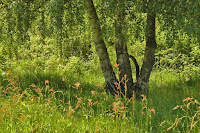I believe in choosing instruments and melodies very carefully. This is an integral part of mixing in my opinion - that most people forget! Way before you are putting compressors, eq and fx on the mixer, choosing the instrument and playing notes that fit in the mix is a great start.
With this attitude, adding 'candy' becomes a lot easier, because the candy will be musically in the right place. The sound and technical stuff then becomes easier!
I also believe in a strong attitude towards believing crazy things will work, rather than sticking with the boring old standards. This usually brings more sparkly and interesting results!
Friday, 1 June 2012
Sunday, 13 May 2012
Tidbit: Less synths, more sounds
I'm greedy for fresh new sounds, which is why I choose to stick to fewer synths than I have before.
It seems silly, but the more synths I add to the studio, the less fresh new sounds I will have at my disposal.
When you know what you want, new synths can hinder the journey towards getting what you want, whereas the synths you know well tend to support this journey.
Ask yourself this question before you explore the rabbit hole of new instruments :)
I hope this helps!
It seems silly, but the more synths I add to the studio, the less fresh new sounds I will have at my disposal.
When you know what you want, new synths can hinder the journey towards getting what you want, whereas the synths you know well tend to support this journey.
Ask yourself this question before you explore the rabbit hole of new instruments :)
I hope this helps!
Wednesday, 18 April 2012
Choose your compression destiny
One of the most useful pieces of mixing advice I've received lately, is categorising compression into two main purposes:
--

- Taming wild vocals, or a wild bass guitar performance.
- Digitally controlled instruments such as synths, may not benefit as much from this.
1. Levelling Compression
2. Enhancing Character / Shaping
2. Enhancing Character / Shaping
--
1. Levelling Compression
Soft, gentle and transparent, you don't hear the compression, you are taming the 'STABS' of sound that you want to sound more controlled, and allow you to turn up the channel safely. Allows you to have loud and soft material on one channel, and always audible. Useful as a first stage compressor.
Examples: LA-2A, CL1B
Purpose:

- Taming wild vocals, or a wild bass guitar performance.
- Digitally controlled instruments such as synths, may not benefit as much from this.
2. Enhancing Character / Shaping
Driving, shaping and colouring. You hear the compression, you are shaping the sound envelope and in some cases, driving a vintage compressor hard to add harmonics. Anything from subtle to dramatic changes here.
Examples: Fairchild 670, 1176, default compressor in your DAW
--
Examples: Fairchild 670, 1176, default compressor in your DAW
- Give instruments that recognisable 'compressed' sound.
- Use the character of vintage compressors (including software emulations) to add colour and warmth.
- Use the character of digital compressors to bring out a clean, sharp quality.
- Use each compressor's unique envelope for shaping:
Shaping:
Emphasise the attack, sustain or release of an instrument.
Attack: Bring out a punchy quality
Sustain: Bring out phrases with long, held notes.
Release: Bring out the breath noise / vocal breaks at the end of each phrase, or even the room reverb of a recording (give a perceptually bigger sound).
--
Saturday, 17 March 2012
Your Perfect Songs May Need To Be Broken
Do you think your audience will prefer to receive perfection? or imperfection?

An average lawn can be comforting for some,
then boring to others.
All of these lawns are both right and wrong, depending on who is experiencing them.
What I find interesting is that songs generally need vulnerability to connect. They need to have a breach, a broken part, an unexpected leak.
As a producer, if you seal these all up with beautiful make up, perfect mixing, and masterful editing. What have you done to the connection of the song?
On the other hand, if you embrace the imperfections of both the song and the artist, you might find a stronger connection start to come your way.
--
then sterile and uncomfortable for another.
A wild lawn can be exciting for one,
then disgusting for another.

An average lawn can be comforting for some,
then boring to others.
All of these lawns are both right and wrong, depending on who is experiencing them.
What I find interesting is that songs generally need vulnerability to connect. They need to have a breach, a broken part, an unexpected leak.
As a producer, if you seal these all up with beautiful make up, perfect mixing, and masterful editing. What have you done to the connection of the song?
On the other hand, if you embrace the imperfections of both the song and the artist, you might find a stronger connection start to come your way.
--
Subscribe to:
Posts (Atom)




